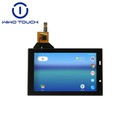Capacitive touchscreens work by sensing the conductive properties of an object, usually the skin on your fingertip. A capacitive screen on a mobile phone or smartphone usually has a glass face and doesn't rely on pressure. This makes it more responsive than a resistive screen when it comes to gestures such as swiping and pinching. Capacitive touchscreens can only be touched with a finger, and will not respond to touches with a regular stylus, gloves or most other objects.
Examples of current smartphones with capacitive touch screens include:
Apple iPhone 3GS and Apple iPhone 4
HTC Desire
Samsung Galaxy S
Samsung Wave

Though resistive touchscreens are often quite responsive — especially in many new smartphones hitting the market — capacitive touchscreens usually provide a more pleasant user experience. Actions like swiping through contact lists, zooming in and out of Web pages and maps, typing e-mails and text messages and scrolling through photos are best suited to capacitive touchscreens; unlike resistive screens, you can swipe across them gently and still get a response. Resistive screens are often found in cheaper devices, as they cost significantly less to manufacture.




